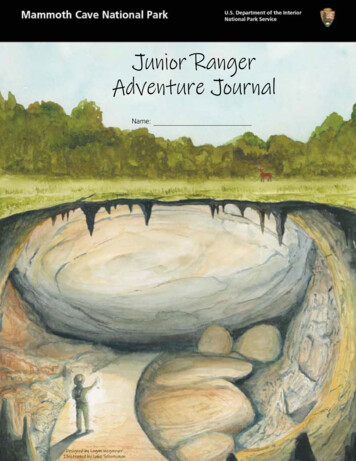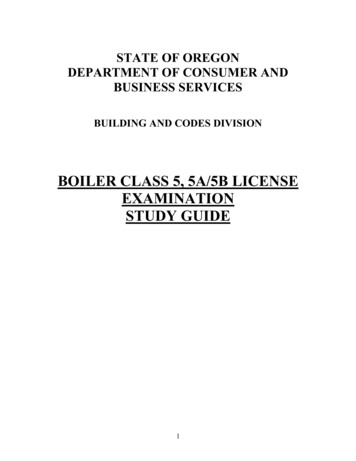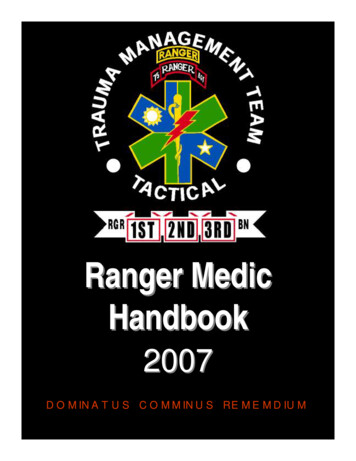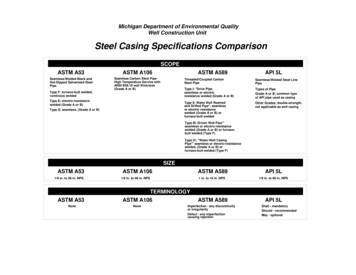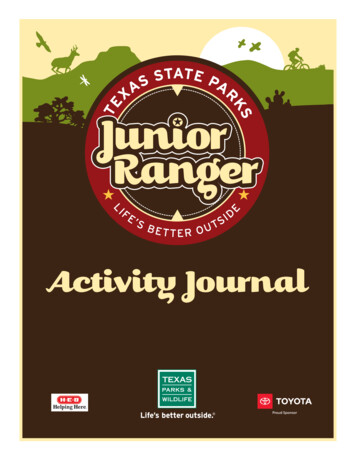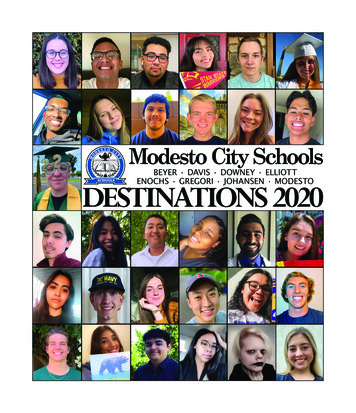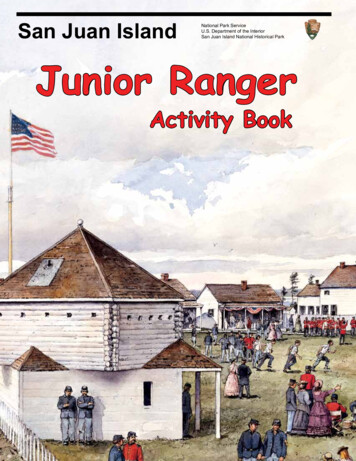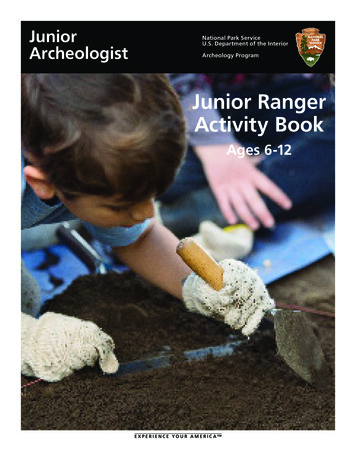
Transcription
JuniorArcheologistNational Park ServiceU.S. Department of the InteriorArcheology ProgramJunior RangerActivity BookAges 6-12E X P E R I E N C E Y O U R A M E R I C A
InstructionsMy name is and I amyears old. I want to be a Junior Archeologist!1) Earn recognition by completing the following number ofactivities. Feel free to complete more than required!6-910-12Symbol.',Age RangeActivities10202) Read and sign the Junior Archeologist Pledge at the endof the activity book.3) Send your completed activity book to the address belowfor official recognition from National Park ServiceArcheology Program headquarters!NPS Chief ArcheologistNational Park Service1849 C Street NW MS 7508Washington, DC 20240Questions?E-mail nps chiefarcheologist@nps.gov1
Mark Your ProgressPAGEInstructions #AGE1Mark Your Progress2-3What is Archeology?4-5Time Capsules6Match Me7Painting Pottery8Home Sweet Home9It’s a Bargain10Past and Present11Step by Step12Let’s Excavate13Digging Deep14Trash Can Archeology15-16Stepping Back in Time17Artifact Sleuth18It Belongs in a Museum192
Mark Your ProgressPAGEArtifact Adventure20Changing Context21Protect Your Site22Archeology Matters23 Dear.24How You Can Help25 Digging Decisions26Why Archeology?27Meet a Ranger28Ranger “Me”29Wrapping It Up30 Glossary31-32Answer Key33-35Jr. Archeologist Pledge3#36AGE
What is Archeology?Archeology happens all over the world, including the nationalparks in the United States and its territories. Get started onyour Junior Archeologist adventure by learning the basics ofwhat archeology is and what archeologists do. Look to theglossary for definitions of bolded words. (Psst: adults andparents – check out the Parent’s Guide). Ready? Let’s go!ARCHEOLOGY is the study of people from the past and their day-to-daylives: what they ate, where they lived, what clothes they wore, what theymade, and what technology they used. Archeologists study people wholived as recently as 50 years ago, or as distantly as 2,000 years ago or more.Sometimes people confuse archeology with GEOLOGY, the study of howthe earth changes over time; PALEONTOLOGY, the study of ancient plantsand animals; or HISTORY, the study of the past through documents, likenewspapers, and personal accounts of what happened, like diaries.Even though archeologists, geologists, paleontologists, and historians allstudy different parts of the past, they sometimes use similar information fortheir research. For example, archeologists and historians both may use olddocuments. Or archeologists, geologists, and paleontologists may all useplant or animal remains that have become rocks, called FOSSILS.While rocks and written documents can help ARCHEOLOGISTS learn moreabout humans and their lives, archeologists have their own unique sourceof information. They use ARTIFACTS, items people have made, used,and left behind. Artifacts could be PROJECTILE POINTS, also known as“arrowheads,” pieces of pottery, called SHERDS, glass bottles, metal nails,musket balls, jewelry, toys, and much more!Archeologists find artifacts at ARCHEOLOGICAL SITES, which can bein cities, in deserts, underwater, in ancient trash piles, called MIDDENS,CONTINUED ON PAGE 54
What is Archeology?CONTINUED FROM PAGE 4and everywhere people could have been! Examples of archeological sitescould be homesteads, battlefields, hunting camps, or cities both ancientand modern. Archeologists study artifacts and sites after carefully recordingwhere they were found and removing them from the ground, throughEXCAVATION.Archeologists use all the information they gather from sites and artifacts tolearn about all the different and interesting ways people have lived aroundthe world and how human CULTURES change throughout time. A culture isa people’s beliefs, activities, and traditions that defines the group and helpsthem identify who they are and what people, places, and things mean tothem.Archeologists take everything they learn through excavation at sites, studythe artifacts more closely, then share the results with other archeologistsand the public. They publish reports or research papers. If you’ve beento a national park, archeology might have come up in an exhibition, aranger talk, or a special tour or event. That’s INTERPRETATION, or howarcheologists get stories about real people in the past to the public.Archeological research and interpretation can be especially meaningfulto descendants of the people whom archeologists have studied. Thesecommunities may have traditional knowledge or memories passed fromgeneration to generation to share with archeologists. ORAL HISTORY isone way for archeologists to record this information. Archeologists anddescendants can learn a lot from each other as both groups try learn moreabout life in the past.Why is archeology so important? Through archeological research, we canlearn about people from many different angles. Archeology can connectdescendants of past peoples to their history. Archeology allows us to learnfrom people in the past, who faced problems we still grapple with today:making friends with new cultures, adapting to changing environments, andlearning new ways of doing things. We can learn from their experiences andgrow together into better people!5
Time CapsulesOne way to think about archeology is the study of “timecapsules.” TIME CAPSULES are containers in which peopleplace meaningful objects for someone in the future to find.Time capsules are often buried and untouched for manyyears, just like archeological sites and artifacts!When you open a time capsule, you only get a small pictureof the past based on a few objects. Archeology can bethe same way: you may only find a few artifacts and haveto use these artifacts to make educated guesses, calledINFERENCES, about how people in the past lived.TIME CAPSULESDIRECTIONS: Draw three items in your time capsule for archeologists in thefuture to find.Imagine an archeologist in the futurefinds your time capsule. What might theseobjects reveal about your life?II6
Archeologists A to ZMany archeologists have a SPECIALTY: they are experts in away of doing archeology. Some specialize in an archeologicalmethod, such as excavating on land or in water. Others areexperts in a past culture, time period, or place.MATCH MEDIRECTIONS: Match the archeologist to what they study.I SCUBA dive to excavatesites. I study shipwrecksin lakes and oceans.Historical archeologistI like the learn abouthow people in the pastthought about the starsand planets.UnderwaterarcheologistI study how people inthe past interacted withanimals.Zooarcheologist7I use historic documentsin my research, andstudy cultures withwritten records.Archeoastronomist
Archeologists A to ZArcheologists study POTTERY to learn about the ways thatart was part of everyday life. SHERDS are pieces of brokenpottery. From sherds, archeologists can infer the shape of apot, its markings, and the way it was made. Pottery helpsarcheologists to learn about cooking and storage, but alsothe significance of decorations, designs, and markings to aperson or a culture.PAINTING POTTERYDIRECTIONS: Design your own pottery below.If an archeologist found your pottery in the future, what might they think?8
Archeologists A to ZSome archeologists study homes from the past. Peoplehave lived in many different types of homes. What could anarcheologist learn about you from studying where you live?HOME SWEET HOMEDIRECTIONS: Match the descriptions of a house on the left to a picture of thathouse on the right.MY HOUSE is built fromwood. I have a brick fireplacefor warmth and cooking.MY HOUSE is built from theearth. I like to work and playon my roof.MY HOUSE is built fromanimal skins. I move arounda lot, so my house is easy topull down and take with me.,.,9
Archeologists A to ZSome archeologists study TRADE, or the exchange of items.In the past, people sometimes traded instead of using money.Archeologists can learn which people were interacting witheach other by finding traded artifacts at sites.IT’S A BARGAINDIRECTIONS: Trade with a neighbor! Make sure you follow the trade regulations.NOTE: There may be more than one correct answer questions 2-5.YOU5 blankets1 gunpowder keg2 lbs. tobacco7 flour barrels3 sugar barrels1 1b. spices1 tin skillet1 whiskey bottleREGULATIONSNEIGHBOR1 tin skillet 1 tin pot3 blankets 1 bolt of cloth2 flour barrels 1 sugar barrel3 sugar barrels 1 china plate1 tin skillet 2 flour barrels1 gunpowder keg 4 lbs. tobacco1 lb. spices 2 china plates1 fur pelt 2 whiskey bottles 1 gunpowder keg1 bolt of cloth 1 whiskey bottle1 lb. tobacco 1 whiskey bottle1 blanket3 gunpowder kegs3 lbs. tobacco2 flour barrels3 china plates2 bolts of cloth1 fur pelt5 whiskey bottles1 tin pot1) What do you think is the most valuable item you have? Why?2) What would you trade to get 2 bolts of cloth?3) What would you trade to get 3 china plates?4) What would you trade to get 1 fur pelt?5) What would your neighbor trade to get 1 lb. spices?10'
Our StoryWhose lives do archeologists study? Archeologists studypeople from the past, people who were like you. Though lifein the past was different from today, there are similarities:people learned, worked, ate, built and maintained shelters,played sports, and had fun.PAST AND PRESENTDIRECTIONS: Match an object from the past to a similar object we use now.What were these objects used for?11
Be an ArcheologistHow do archeologists find out information about the past?We come up with research questions, dig for artifacts, studythose artifacts, and share what we learn with others!STEP BY STEPDIRECTIONS: Archeological excavation must be done in a specific order, andincludes much more than just digging. An archeologist’s “To Do” list below needsto be ordered correctly 1-9.TO DOWriteon informationsite report basedfrom artifactse notes onktadna,hprag, photoCatalog, washring excavationsartifacts found duonlaces for excavatipseoochtopadmUse survey anh questioning researcploveedybrttaSd site and makeSurvey the selectean accurate map;research questionreswnatonlaphtDesign researcle, and set budgepoept,nemipuqselect site, eugh publicationsrothrtopreethation inShare informibitionsand museum exhfullyntifically and careiescgntivaaxceBeginnished excavatingfinehwblaeths toMove artifact12'
Let’s ExcavateWhen archeologists excavate, they do much more than justdig holes and find artifacts.123(1) Archeologists start excavations by laying ropes in lines to form boxes, calledUNITS. When an artifact is found in one of these units, archeologists willknow where it was found compared to other artifacts at the site.(2) Using a special shovel, called a TROWEL, archeologists carefully dig up dirt.(3) Archeologists place the dirt on top of screens and (4) sift through the dirt tomake sure no small artifacts are accidentally left behind.4756(5) Once the dirt has been sifted, the leftover dirt isdumped into buckets.(6) When artifacts are found, they are placed inplastic bags and labeled.(7) Archeologists are always recording theirOBSERVATIONS, or things they notice about theartifacts, in their field notebooks.13
Stories in the SoilArcheologists need to know how deep in the ground anartifact was found, because an artifact’s depth is importantfor determining how old it is. An archeological site hasmany layers. Studying the different layers of soil is calledSTRATIGRAPHY. The deeper you dig, the older an artifact is!DIGGING DEEPDIRECTIONS: Answer the following questions about artifacts A-F from thisarcheological site.TopsoilALoam1) Which artifact is the oldest?2) Which artifact is the most recent?3) Which artifact is in silt?ED4) Which artifact is older, C or F?BSiltClayFC5) If each soil layer takes about 150 years tobuild up, estimate how many years oldartifact F might be.SandBedrock6) Why do you think it is important to knowhow old an artifact is?14'
Trash Can ArcheologyIn MIDDENS, or trash piles from the past, archeologistsmay find food, clothes, pottery – all kinds of things! Often,middens were used for a long time, so archeologists can learnhow communities changed over time.One person’s trash can be an archeologist’s treasure!DIRECTIONS: Excavate a trash can. Choose a trash can in your house as yourarcheological site, and use the site record on page 16 to record what you find.Start from the top and work you way to the bottom of the can. Observe eachobject and then make inferences based on what you have observed. After you’refinished excavating, answer the questions below.1) What conclusions do you have about the people who left this trash behind?2) What are the oldest artifacts? How do you know?3) Compare and contrast this activity and archeologicalresearch in the field (see page 13)?15
Trash Can ArcheologySITE RECORDOBJECT #OBSERVATIONSINFERENCESExample2 in. x 6 in. piece of thin,white paper; indicates therewas a transaction of 20.33for a variety of food items; asignature is at the bottomIt’s likely that the people wholived here had a standardcurrency, could read and write,and could frequently buy a varietyof food items from one location.16'
Getting a DateArcheologists use artifacts to put together a time line of howpeople used a site in the past, called a site’s CHRONOLOGY.There are two ways archeologists find out how old a site is:1) RELATIVE DATING: using stratigraphy to know howold an artifact is compared to other artifacts2) ABSOLUTE DATING: using scientific processes tocalculate a numerical age for an artifactSTEPPING BACK IN TIMEDIRECTIONS: Use the time line to answer the questions. Take one step for each100 years.NOTE: 2000 CE is “now.” CE stands for Common Era, also known as AD, orAnno Domini.Aztec EmpireI1500 CEIIIII1000 CE2000 CEIIIIII500 CEIIIIII0 CEIMayan Empire peaksIIMound-building cultures inNorth America1) For about how many “steps” did the Aztec Empire (1200-1500) exist?2) About how many steps would take you back to the earliest peak of theMayan Empire (300-900)?17'3) For about how many steps did the Mayan Empire and the mound builders(800-1600) overlap?
Artifact AnalysisArtifacts are clues to activities in the past. Archeologistsclosely observe artifacts’ characteristics, then put together theclues to understand what people did with them, and why.ARTIFACT SLEUTHDIRECTIONS: Select an object in your home. Pretend you have never seen thisobject before, and think of it as an artifact. Sketch the object below and answerthe questions.1) What materials is it made of?2) What is its texture?3) How much does it weigh?4) How tall, wide, and long is it?5) What colors is it?6) What do you think it is used for? Why?18'
It Belongs in a Museum.·· . .·.1 .1) Include descriptive information about the object2) Share why this object may be important3) Share with museum visitors why this object is interesting.DIRECTIONS: Choose an object in your home, (you canuse the same artifact from the activity on page 18). Help amuseum curator create an exhibition. Sketch the object belowand write a label for the object. Your label should:Object:Dates to:Location found:Made by:More information:'19
Artifact AdventureDIRECTIONS: Sometimes artifacts take a long journey before being found by anarcheologist. Join in on the adventure! You will need one small token per player(like a button) and a coin. Each player flips the coin at the start of their turn, andmoves forward one space for heads and two spaces for tails.STARTThe arrowhead breaks during ahunting trip! The hunter stops andtries to repair it.A hunter makesa point for thetip of his arrow.The brokenarrowheadwashes up ona river bank.Someone seesit, and lets anarcheologistknow aboutthe artifact.SKIP NEXT TURNFINISHThe arrowheadis found by anarcheologist!MOVE AHEADONE SPACEThe arrowheadcan’t berepaired. Thehunter leaves itat his camp sitewhen he movesto anotherlocation tohunt.MOVE AHEADONE SPACEFor years, the broken arrowhead ismoved around by rivers,rain storms, and animals.MOVE BACK TWO SPACES20
Puzzle PiecesAn artifact needs the CONTEXT, or a place in time andspace, of its archeological site for an archeologist to learn asmuch information as possible. When an artifact is removedfrom its context, archeologists can make wrong inferences.CHANGING CONTEXTDIRECTIONS: Observe the artifacts below. Answer the following questions.1) What do you think happenedat this site? Think about howthe artifacts might have beenused.2) How would the story change ifthe doll wasn’t found at thesite? The horseshoe?21
Preserving the PastArcheologists study people who lived in the past. Butinformation about these people is being threatened assites are destroyed by weather, animals, and humans.Archeologists need to be aware of these threats and makesure that their sites are protected so information about thepast is not lost.PROTECT YOUR SITEDIRECTIONS: Unscramble the words to identify the threats to your archeologicalsite. Think about how you could protect archeological sites from these threats.IUHRNRCAECIOOTRUNSCTNGLTIOONEFRITERE RTOOSDRONETS22
Archeology MattersWe need more than just laws to keep archeological sites safe.We need Junior Archeologists, like you, to act as ambassadorsfor archeology and help preserve sites for the future.One of the worst ways that archeological sites are destroyed is throughLOOTING. This is when people illegally take artifacts from sites in a nonscientific way.Often, looters use metal detectors or other equipment to find sites. Theymight dig for pottery in the Southwestern United States, or metal CivilWar battle artifacts in the Southeast, often ignoring artifacts that do notseem exciting or valuable. Most of the time, these artifacts are for looters’personal collections or are sold to other people for a profit.Why is looting bad? As we learned on pages 12 and 13, archeologicalresearch is more than just digging for exciting artifacts. Archeology is ascience: we dig only when we need to answer specific and importantquestions about people in the past. We always record everything aboutwhere an artifact was found. We share what we learn with everyonethrough interpretation, and we never sell artifacts for a profit.Archeological excavation is a one-time thing: once a site has been excavated,it can never be re-excavated in the same way again. Archeologists take thisresponsibility very seriously. When a site is looted, information is lost forever.Archeologists could also be misled through incorrect information. Think backto the activity on page 21: how did the story change if certain artifacts werenot found at the site? Sometimes archeologists do not know that a site hasbeen looted and make wrong inferences about the site because artifacts aremissing.Looting is against the law in many places in the United States, includingthe national parks. But this does not stop people from looting. Many lawsin the United States protect archeological sites. These laws have beenpassed because U.S. citizens think archeology is important and our sites areimportant to protect for the future.23
Dear.As Junior Archeologists, we know that archeology isimportant and that archeological sites should be protected.However, not everyone knows what we know, and peoplecontinue to destroy our shared past.DIRECTIONS: Write a letter to an imaginary person who loots archeological sites.Use what you know about archeology to convince this person to stop looting.DearSincerely,24
How You Can HelpDIRECTIONS: Read how you can help protect archeological sites. Then find allthe underlined words in the puzzle.NOTE: Words can be found in the puzzle backwards and diagonally.Archeological sites are being destroyed at an alarming rate. If people like youstand up for archeology, that might change. You can help by setting a goodexample for others and sharing what you have learned as a Junior Archeologist.Archeology tells important stories, and each artifact is part of that story. If youfind artifacts in the nationalT IP R E S E R V E F O C Rparks, leave them where youfound them and tell a ranger.CG LL E IR AAU POMORemember, removing artifactsAUNI NI LOOT I NI GPGfrom their context erases crucialF IR O I A IR U ET PF IR IRinformation about that artifact.If you see other people removingartifacts, tell a ranger. Looting isillegal in national parks. It is alsoillegal to use a metal detector atnational parks. People who takeartifacts from public lands arestealing from our shared past.II ETLYOTTTE IH EAXLA I ID T IRIR OTCETE ID LATEMAR ID E YO IR TSE ID C IPNI I ETNI E LSSOGTAGE IR DEOAOTAPAEESCTABPFGSPOLIR EAYMLGE LY ID IR ENI TNI ATROPM I OOLAct as an ambassador forarcheology. If someone isunaware of why archeology isimportant, speak up! Share what you know about the stories told by archeology.If more people understand that archeology is important and want to preserveand protect sites, less sites will be destroyed.Your words and opinions matter!You can help preserve our past for our future.25
The Right ThingArcheologists often have to think about ETHICS, or thedifference between doing what is right and what is wrong.Sometimes doing the right thing is hard, but archeologistshave a responsibility to be ethical. Doing the right thing is asign of respect to other archeologists and people in the past.DIGGING DECISIONSDIRECTIONS: Consider the decisions archeologists made. Decide if you think thearcheologists did the right thing or the wrong thing.RIGHTWRONG DECISIONAn archeologist goes out of their way to sharetheir research with others through publications andmuseums. An archeologist sees a volunteer on a dig sneak anartifact into their pocket. The archeologist doesn’t sayanything and lets the volunteer take the artifact fromthe site. An archeologist notices their site has been disturbed.They contact the authorities, document the damage,and do their best to ensure that the site is protectedthroughout the rest of the dig. An archeologist sells an object they found to acollector so they can increase their funding forfurther research.26
Why Archeology?We have learned that archeologists study how people inthe past lived by observing the sites and artifacts they leftbehind. But why is archeology important? If we didn’t havearcheologists to excavate sites, what would be lost?DIRECTIONS: In the space below, express why you think archeology is important.Photo by Alicia Paresi27
Meet a RangerDIRECTIONS: With a guardian, use www.nps.gov to find national parks near you.If possible, visit a national park and interview a ranger. Alternatively, contact apark via e-mail or phone and ask to interview someone at the park remotely.Park:Ranger:1) How long have you been a ranger in the National Park Service?2) Why did you decide to become a ranger?3) What archeological research has been conducted at the park?4) Can you tell me about people from the past who are important to this park?5) Why do you think archeologyis important?28
StorytellersThe United States has some of the most incredible archeologysites. RANGERS at national parks share our nation’sarcheology with visitors from all around the world.RANGER “ME”DIRECTIONS: Use the space below to draw yourself as a ranger at a nationalpark. What you would tell visitors about archeology?,.,29
Wrapping it UpDIRECTIONS: Test your knowledge of what you learned as a Junior Archeologist!HINT: Answers are BOLDED throughout the activity book.123456789ACROSSDOWN4. Objects archeologists find6. Those who study people andartifacts from the past8. A place in time and space9. A destructive, illegal behavior1. Small pieces of broken pottery2. Studying different soil layers3. Scientific digging5. Trash piles from the past7. A time line of events30
GlossaryABSOLUTE DATINGARCHEOLOGICAL NCEINTERPRETATION31Using scientific processes to calculate anumerical age for an artifactPlaces where archeologists excavate tofind artifactsA trained professional in archeologyStudy of past peoples and culturesthrough their sites and artifactsAn object made or used by humansA time line of when events happened inorder from oldest to newestA place in time and spaceA people’s beliefs, activities, andtraditions that defines that group andhelps them identify who they are andwhat is important to themThe difference between doing what isright and doing what is wrongThe scientific removal of artifacts froman archeological sitePlant or animal remains that havemineralized into rocksThe study of how the earth changesThe study of the past throughdocuments and personal accountsAn educated guessHow people use museums, ranger talks,field trips, etc. to tell true stories aboutthe past
GlossaryLOOTINGMIDDENOBSERVATIONORAL HISTORYPALEONTOLOGYPOTTERYPROJECTILE POINTRANGERRELATIVE DATINGSHERDSPECIALTYSTRATIGRAPHYTIME CAPSULETRADETROWELUNITSThe illegal destruction of archeologicalsites through the non-scientific removalof artifactsTrash pile from the pastSomething you notice when lookingclosely at an artifactStories passed from generation togenerationThe study of ancient plants and animalsObjects made from clay; often decoratedThe scientific name for “arrowheads”Someone who works for the NationalPark ServiceUsing stratigraphy to know how old anartifact is compared to other artifactsA small piece of potteryA time period or place an archeologistknows a lot aboutThe study of different layers of soil usedto determine how old an artifact isContainers in which people place objectsfor someone in the future to findAn exchange of goods; used instead ofmoneySpecial shovel used by archeologistswhile excavatingBoxes formed when using ropes todivide a site into a grid32
Answer KeyActivity: Match MePage: 7ArcheoastronomistHistorical archeologistI use historic documents in my research, and studycultures with written records.I like the learn about how people in the pastthought about the stars and planets.ZooarcheologistUnderwater archeologistI SCUBA dive to excavate sites. I study shipwrecksin lakes and oceans.Activity: Home Sweet HomeI study how people in the past interacted withanimals.Page: 9MY HOUSE is built from wood.I have a brick fireplace forwarmth and cooking.MY HOUSE is built from theearth. I like to work and play onmy roof.Activity: It’s a BargainMY HOUSE is built from animalskins. I move around a lot, so myhouse is easy to pull down andtake with me.Page: 101) 1 lb. spices. Because, according to the trade regulations,the spices can be traded for 2 china plates(worth 3 sugar barrels each), making the spices the most valuable item.2) 3 blankets and 1 whiskey bottle3) 1 lb. spices and 3 sugar barrels4) 1 gunpowder keg and 2 lbs. tobacco5) 2 china platesActivity: Past and Present33Page: 11
Answer KeyActivity: Step By StepPage: 128 Write site report based on information from artifacts7 Catalog, wash, photograph, and take notes on artifacts found during excavations4 Use survey and map to choose places for excavation1 Start by developing research question3 Survey the selected site and make an accurate map2 Design research plan to answer research question; select site, equipment, people, and set budget9 Share information in the report through publications and museum exhibitions5 Begin excavating scientifically and carefully6 Move artifacts to the lab when finished excavatingActivity: Digging DeepPage: 14Activity: Stepping Back in TimePage: 171) F2) A3) B4) F5) 750 years6) The age of an artifact can tell you when a sitewas used by humans in the past. Stratigraphyplaces everything in context, a place in time andspace, which is crucial for archeological research.1) 32) 173) 1Activity: Digging DecisionsPage: 26RIGHTActivity: How You Can HelpPage: 25E S E RAn archeologist goes out of their way to sharetheir research with others through publicationsand museums.An archeologist notices their site has beendisturbed. They contact the authorities,document the damage, and do their best toensure that the site is protected throughout therest of the dig.WRONGRA RN I EGERE S CREAn archeologist sees a volunteer on a dig sneakan artifact into their pocket. The archeologistdoesn’t say anything and lets the volunteer takethe artifact from the site.An archeologist sells an object they found to acollector so they can increase their funding forfurther research.34
Answer KeyActivity: Protect Your SitePage: 22Activity: Wrapping it UpPage: 30IU HR N R CA EHU R R I C A N EC I O O TRU N SC TNC O N STR U C TI ONGLT I O O NLO O T I NGEFRIFI R EACROSS4. Artifacts6. Archeologists8. Context9. LootingTERE RTOOSTREE ROOTSD R O N ETSR O D EN TSDOWN1. Sherds2. Stratigraphy3. Excavation5. Middens7. ChronologyUnless otherwise specified, all photos courtesy of the National Park Service.Junior Archeologist activity book created by Leah Burgin, with thanks to the NPS Archeology Program.35
Junior Archeologist PledgeAS A JUNIOR ARCHEOLOGIST,I PLEDGE TO:EXPLORE ARCHEOLOGY IN MYCOMMUNITY AND LEAVE DIGGINGTO THE PROFESSIONALSLEARN MORE ABOUT ARCHEOLOGYPROTECT OUR NATIONAL PARKSAND ARCHEOLOGICAL SITESSHARE WHAT I KNOW ABOUTARCHEOLOGY WITH OTHERSSIGNATURE:DATE:36
MORE TO EXPLORE!1) Go to www.nps.gov/archeology to learn more aboutarcheology in the national parks2) Check out your regionalNational Park Service ArcheologyCenters for local events3) Find national parks near youat www.nps.gov4) Become a Junior Ranger tm
JuniorArcheologistNational Park ServiceU.S. Department of the InteriorArcheology ProgramParent GuideUse this guide to dig deeper into archeology with your JuniorRanger. Pose discussion questions while your Junior Rangerworks on the activity book, or pursue extension activities andother reading afterthe activity book iscompleted.ES:THATUREFEDIUIS IVITIEADINGERREHTFURIONSSUGGESTWe hope theparent guideinspires you to findmore opportuni
1 whiskey bottle. YOU. 1 tin skillet 1 tin pot 3 blankets 1 bolt of cloth 2 flour barrels 1 sugar barrel 3 sugar barrels 1 china plate 1 tin skillet 2 flour barrels 1 gunpowder keg 4 lbs. tobacco 1 lb. spices 2 china plates 1 fur pelt 2 whiskey bottles 1 gunpowder keg 1 bolt of cloth
